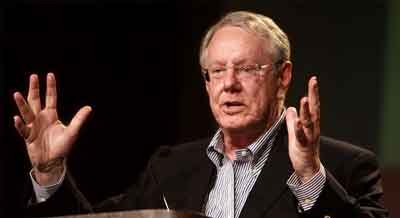Steve Forbes Infuriates Global Elite with New Gold Prediction
Peter Reagan
 Steve Forbes demands a return to the gold standard, gold’s fair value is closer to $3,000 than its current price, and U.S. states aren’t waiting for a national gold standard – they’re busy authorizing their own. Steve Forbes demands a return to the gold standard, gold’s fair value is closer to $3,000 than its current price, and U.S. states aren’t waiting for a national gold standard – they’re busy authorizing their own.
Steve Forbes: the gold standard solves all our economic challenges
Steve Forbes, as mainstream an investor and businessman as you’ll find in the nation, is openly calling for a return to the gold standard.
Why? Forbes offers a number of compelling reasons, primarily:
A gold-based monetary system would have prevented our present woes, not to mention this century’s previous economic and banking disasters.
Inflation never occurs with a gold standard.
Had we maintained our gold-based average [GDP growth], the median household income in the U.S. would now be around $110,000, not today’s $70,000—$40,000 more.
A nation always performs better when on a gold standard. That and low tax rates are fundamental for long-term prosperity. Always.
So, let us ask, is a return to a gold standard even possible?
Some say yes, some say no. Forbes proposes, as an example, that the U.S. dollar is pegged to gold with a $1,900/oz price (which means every dollar is worth 1/1,900th oz of gold, or about ½ of a Goldback). That’s not exactly realistic, though. Consider the numbers:
Simple math tells us that, should we return to a gold standard today, the price of gold would be a mind-boggling $80,000/oz.
Is a gold standard good or bad for gold investors, then? These are the kind of puzzles that the Fed, and money printing in general, has thrown into our laps. Forbes accurately points out that the 1775-1900 period put the U.S. on the map as an economic superpower – furthermore, the indisputable claim that inflation was basically nonexistent! The gold-tethered U.S. dollar was so well-regarded that we’re still coasting on it.
But the numbers can’t be ignored. Forbes notes that even in the 1950s and 1960s, for example, the average annual growth rate in the U.S. was 4.2%, while these days it clocks in around 2.7%. Yet it’s known that the creation of the Fed in 1913 paved the way for inflation even with the gold standard around. And the 1971 version of the gold standard, which didn’t allow U.S. citizens to swap their paper money for “cold hard cash,” was already a watered-down version of the pre-1900 gold standard, where every dollar bill was redeemable on demand for gold or silver.
It stands to reason, then, that the Fed’s function would have to change in some capacity in order for the gold standard to work to begin with. Given that central banks pretty much introduced inflation to global economies, they aren’t likely to spearhead a sound money movement. Unfortunately for those who don’t own gold, it seems that the solution will continue being a tried and tested one: print, and print more.
All this additional currency doesn’t create more wealth – but it does create the illusion of wealth. Forbes points out the difference:
Money is a measure of value, just as scales measure weight, clocks measure time and rulers measure length. We instinctively understand the need for fixed weights and measurements in the marketplace. The volume of a gallon doesn’t change each day, nor does the number of ounces in a pound, the inches in a foot or the minutes in an hour. An economy works best when its currency is a reliable measure of value.
Money that is fixed in value makes buying, selling and investing easier, just as fixed weights in grocery stores make it easier to shop—a pint of ice cream today is the same size and amount as it was yesterday.
Can our nation ever get back to a place where the quality of money doesn’t change from year to year? Not without some pretty big changes! Meanwhile, things will continue as they have until the next financial crisis forces us to start asking hard questions…
And while this “death of a thousand cuts” is nothing to be happy about in general, for the prudent and well-diversified investor, it’s nothing to worry about, either.
Eric Strand: Gold below $3,000/oz is a bargain
Eric Strand, founder and portfolio manager at AuAG funds, believes we might be on the cusp of the next big gold bull market. That sounds strange, considering the movements of the past few years.
Nonetheless, Strand thinks that the next year will create some interesting scenarios for both gold and silver. He recently explained the $2,000 price is important because it’s perhaps the biggest hurdle. Once past it comfortably, Strand expects gold to climb all the way up to $3,000.
The methods through which this will be achieved are hardly a mystery. Talking out of Sweden, Strand reminds us that gold has already hit all-time highs in European currencies such as the euro and the pound. It’s the dollar’s strength that has kept gold back in greenback terms, and it’s the same strength that will bring about a double correction of sorts. Not only will gold gain in general, says Strand, but the U.S. dollar will pull back against other top currencies. This will make U.S. investors positioned to reap even greater returns during this bull run than European ones.
Strand notes that the U.S. national debt issue that was created in 2008 wasn’t addressed, and we now have twice as much debt. The popular solution will prove to be the most favorable yet again, Strand noted: print money and lower interest rates – inflate away the debt. He mentioned that we might already be seeing the start of this process, considering the Fed’s hesitation to keep raising interest rates in light of the banking crisis.
For all of gold’s gains, Strand is even more excited about silver. Because silver is recycled a lot less than gold, silver’s supply is far more constrained than gold’s. The gold/silver ratio is around 82, with an average being 30 and the intended average being 16. Strand expects a normalization to 30 during the coming bull run in precious metals, which would bring silver above valuations of $100.
States aren’t waiting for a national gold standard
Remember the U.S. Constitution? If you do, it’s difficult to miss this passage:
No State shall enter into any Treaty, Alliance, or Confederation; grant Letters of Marque and Reprisal; coin Money; emit Bills of Credit; make any Thing but gold and silver Coin a Tender in Payment of Debts; pass any Bill of Attainder, ex post facto Law, or Law impairing the Obligation of Contracts, or grant any Title of Nobility.
States are slowly but surely remembering that, in order to be called states under the Constitution, they’re meant to use gold and silver as legal tender. Some say that a digital dollar might be rolled out as early as July. Among its many problems, Robert E. Wright, a Senior Research Fellow at the American Institute for Economic Research, notes that a CBDC might not even qualify as moneyunder the Constitution.
As funny money turns into crazy money, it’s good to know that efforts are being made in the opposite direction. The Sound Money Defense League has been a key mover in getting sales tax on gold and silver eliminated from 42 states, but that’s just the start.
Missouri’s SB-100 bill would give citizens the right to use gold and silver as legal tender. Missouri is one of 23 states with similar bills, 10 of which have been introduced this year alone.
The bill hasn’t actually mentioned the U.S. dollar past saying CBDCs shouldn’t be enforced, and it’s pretty clear why. Any return to sound money might as well be interpreted as an attack on the U.S. dollar, so making gold and silver seem like an option next to the greenback apparently gives the bill a greater chance of success. If nothing else, the bill could rescue us from what looks like a public pension crisis.
Exciting times for gold bullion, and less so the U.S. dollar. The bills also mention state depositories to some lengths, having obviously been reminded of the importance of a sovereign nation holding bullion.

Peter Reagan is a financial market strategist at Birch Gold Group. As the Precious Metal IRA Specialists, Birch Gold helps Americans protect their retirement savings with physical gold and silver.
www.newsmax.com
| ![[Most Recent Quotes from www.kitco.com]](http://www.kitconet.com/images/live/s_gold.gif)
![[Most Recent USD from www.kitco.com]](http://www.weblinks247.com/indexes/idx24_usd_en_2.gif)
![[Most Recent Quotes from www.kitco.com]](http://www.kitconet.com/images/live/s_silv.gif)


